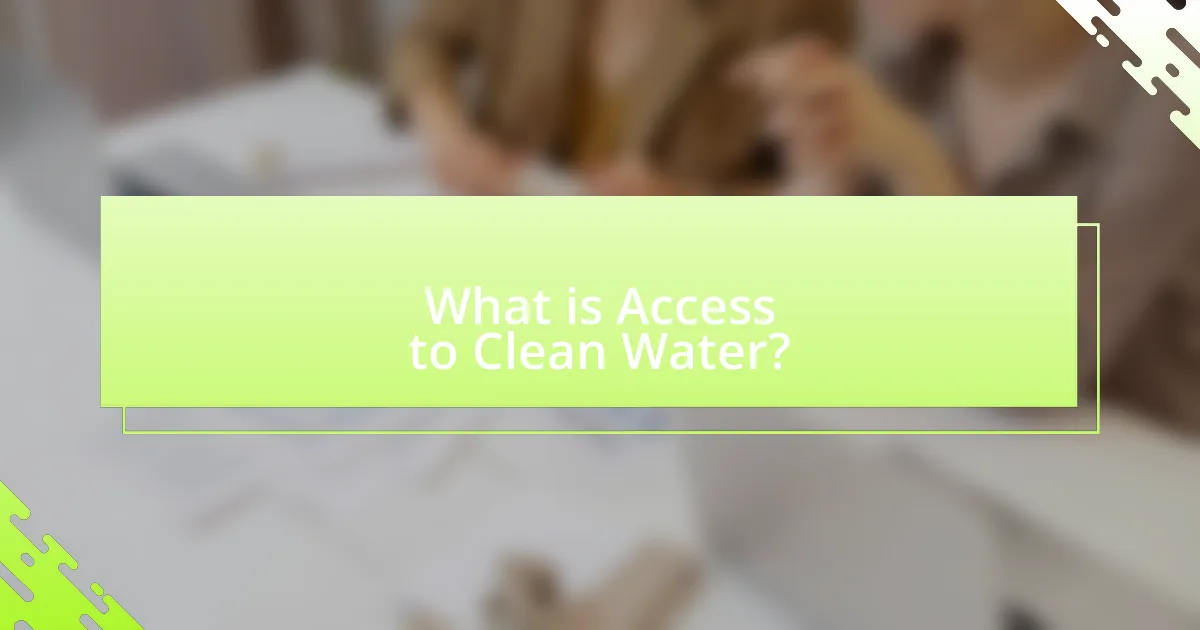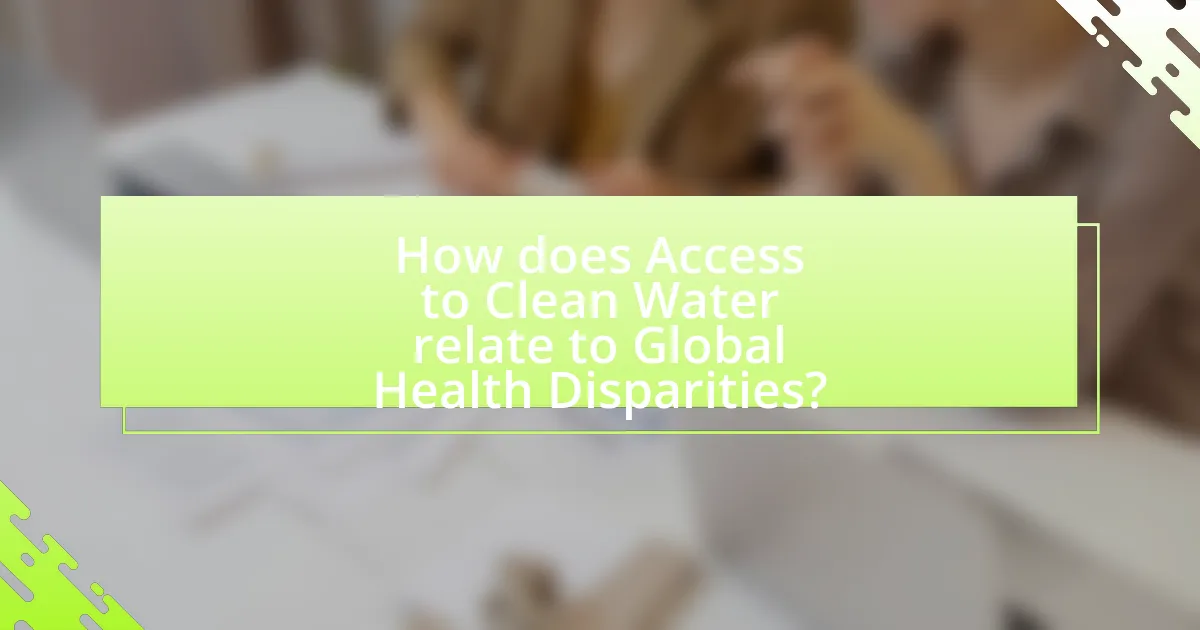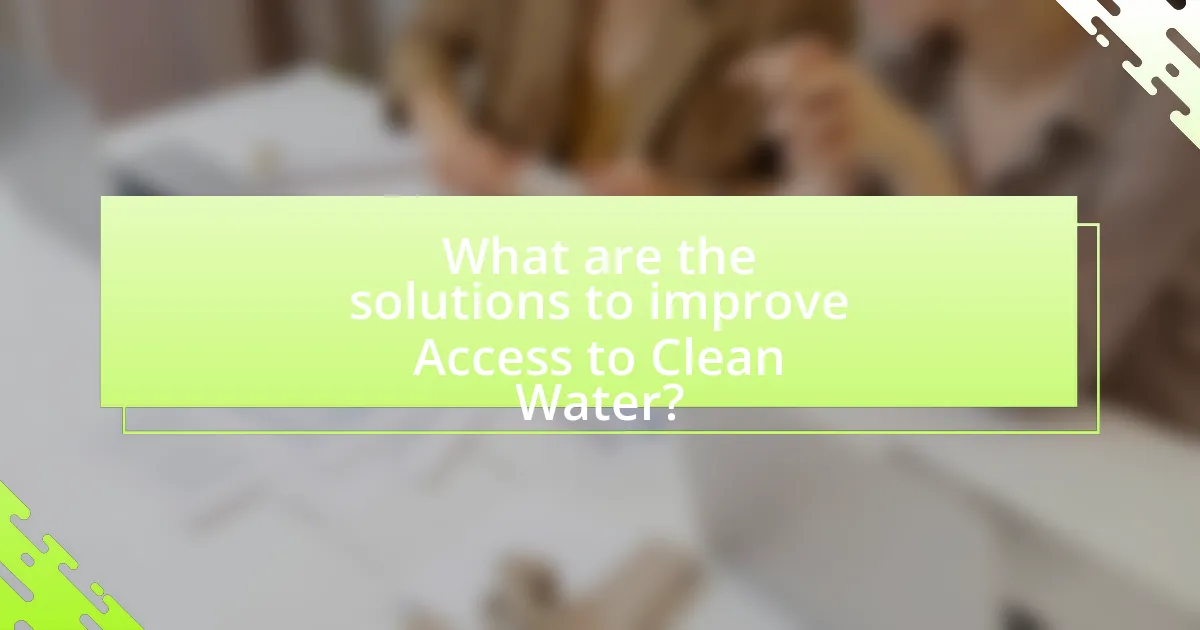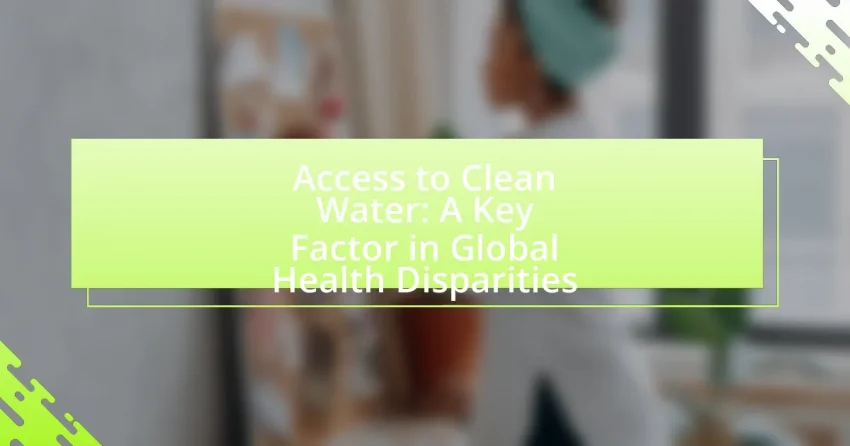Access to clean water is a critical determinant of global health disparities, impacting health, nutrition, education, and economic productivity. Approximately 2 billion people lack access to safely managed drinking water services, leading to increased rates of waterborne diseases such as cholera and dysentery, particularly in low-income regions. The article explores the essential role of clean water in preventing diseases, the socioeconomic factors influencing access, and the significant health risks associated with inadequate water supply. It also discusses the economic implications of water access, current initiatives to improve water infrastructure, and strategies for community engagement and advocacy to enhance clean water access globally.

What is Access to Clean Water?
Access to clean water refers to the availability of safe, potable water for drinking, sanitation, and hygiene purposes. It is essential for maintaining health and preventing waterborne diseases, which can lead to significant morbidity and mortality. According to the World Health Organization, approximately 2 billion people lack access to safely managed drinking water services, highlighting the critical nature of this issue in global health disparities. Access to clean water is not only a basic human right but also a fundamental component of public health, as it directly impacts nutrition, education, and economic productivity.
Why is access to clean water essential for health?
Access to clean water is essential for health because it prevents waterborne diseases and supports overall bodily functions. Contaminated water sources can lead to illnesses such as cholera, dysentery, and typhoid fever, which are responsible for millions of deaths annually, particularly in low-income countries. According to the World Health Organization, improved water quality can reduce the incidence of these diseases by up to 50%. Furthermore, clean water is vital for hydration, sanitation, and hygiene, which are critical for maintaining health and preventing the spread of infections.
What are the health risks associated with lack of clean water?
Lack of clean water poses significant health risks, including the spread of waterborne diseases such as cholera, dysentery, and typhoid fever. These diseases arise from contaminated water sources, leading to millions of deaths annually; for instance, the World Health Organization estimates that unsafe water contributes to over 500,000 deaths from cholera each year. Additionally, inadequate access to clean water can result in malnutrition and dehydration, particularly in vulnerable populations like children, who are more susceptible to the effects of contaminated water. The absence of clean water also exacerbates existing health conditions and increases healthcare costs, further impacting communities already facing health disparities.
How does clean water impact overall community health?
Clean water significantly enhances overall community health by reducing the prevalence of waterborne diseases. Access to clean water decreases the incidence of illnesses such as cholera, dysentery, and typhoid fever, which are often caused by contaminated water sources. According to the World Health Organization, improved water quality can lead to a 30% reduction in diarrheal diseases, which are a leading cause of morbidity and mortality, particularly among children under five. Furthermore, clean water supports better sanitation and hygiene practices, contributing to overall health improvements and increased productivity within communities.
What are the global statistics on access to clean water?
As of 2023, approximately 2 billion people globally lack access to safely managed drinking water services. This statistic highlights a significant disparity in access to clean water, with 785 million people lacking even basic drinking water services. According to the World Health Organization, 29% of the global population does not have access to safely managed sanitation services, which further exacerbates health issues related to water quality. These figures underscore the critical need for improved water infrastructure and sanitation to address global health disparities.
Which regions face the greatest challenges in accessing clean water?
Sub-Saharan Africa faces the greatest challenges in accessing clean water. According to the World Health Organization, approximately 319 million people in this region lack access to safe drinking water, contributing to high rates of waterborne diseases. Additionally, regions like South Asia, particularly India and Bangladesh, also struggle significantly, with millions relying on contaminated sources. These statistics highlight the severe disparities in water access, which directly impact public health and economic development in these areas.
How do socioeconomic factors influence access to clean water?
Socioeconomic factors significantly influence access to clean water by determining the availability of resources, infrastructure, and services necessary for water supply. Individuals in lower socioeconomic groups often reside in areas with inadequate water infrastructure, leading to limited access to safe drinking water. For instance, according to the World Health Organization, approximately 2 billion people lack access to safely managed drinking water services, with the majority residing in low-income countries. Additionally, economic constraints can hinder investments in water purification technologies and sanitation facilities, exacerbating health disparities. Thus, socioeconomic status directly correlates with the ability to secure clean water, impacting overall public health outcomes.

How does Access to Clean Water relate to Global Health Disparities?
Access to clean water is a critical determinant of global health disparities, as inadequate access leads to increased rates of waterborne diseases, malnutrition, and mortality, particularly in low-income regions. According to the World Health Organization, approximately 2 billion people lack access to safely managed drinking water services, which contributes to the prevalence of diseases such as cholera and dysentery, disproportionately affecting vulnerable populations. Furthermore, the lack of clean water exacerbates health inequities, as communities without reliable water sources face higher healthcare costs and lower productivity, perpetuating cycles of poverty and poor health outcomes.
What are the key health disparities linked to water access?
Key health disparities linked to water access include increased rates of waterborne diseases, malnutrition, and maternal and child mortality. Inadequate access to clean water leads to the spread of diseases such as cholera and dysentery, which disproportionately affect vulnerable populations, particularly in low-income countries. According to the World Health Organization, approximately 2.2 million people die each year from diarrheal diseases, primarily due to unsafe water and poor sanitation. Furthermore, lack of clean water contributes to malnutrition, as it affects food production and hygiene practices, exacerbating health issues in communities. Additionally, women and children often bear the burden of water collection, which can hinder their access to education and healthcare, further perpetuating health disparities.
How does lack of clean water contribute to disease prevalence?
Lack of clean water significantly contributes to disease prevalence by facilitating the spread of waterborne pathogens. When communities do not have access to safe drinking water, they are more susceptible to diseases such as cholera, dysentery, and typhoid fever, which are transmitted through contaminated water sources. According to the World Health Organization, approximately 2 billion people globally use a drinking water source contaminated with feces, leading to an estimated 485,000 deaths from cholera each year. This correlation between unclean water and disease highlights the critical need for improved water sanitation and hygiene to reduce health risks.
What role does clean water play in maternal and child health?
Clean water is essential for maternal and child health as it significantly reduces the risk of waterborne diseases and improves overall health outcomes. Access to clean water during pregnancy helps prevent complications such as dehydration and infections, which can adversely affect both the mother and the developing fetus. Furthermore, clean water is crucial for safe childbirth practices and postnatal care, as it minimizes the risk of infections that can lead to maternal and neonatal mortality. According to the World Health Organization, inadequate water supply and sanitation contribute to approximately 1.5 million child deaths annually, highlighting the critical link between clean water access and child health.
How does access to clean water affect economic development?
Access to clean water significantly enhances economic development by improving public health and productivity. When communities have reliable access to clean water, the incidence of waterborne diseases decreases, leading to lower healthcare costs and increased workforce participation. For instance, the World Health Organization estimates that every $1 invested in water and sanitation can yield a return of $4 in increased productivity. Additionally, clean water access supports agricultural productivity, as irrigation becomes more efficient, thereby boosting food security and local economies. These factors collectively contribute to sustainable economic growth and development in affected regions.
What are the economic costs of inadequate water access?
Inadequate water access incurs significant economic costs, including increased healthcare expenses, lost productivity, and reduced agricultural output. For instance, the World Health Organization estimates that inadequate water access leads to approximately 1.5 million deaths annually from waterborne diseases, resulting in substantial healthcare costs for families and governments. Additionally, individuals without reliable water access often spend hours collecting water, which translates to lost labor hours and decreased economic productivity. Furthermore, agricultural sectors suffer as farmers face challenges in irrigation, leading to lower crop yields and food insecurity, which can exacerbate poverty levels. Collectively, these factors contribute to an estimated economic loss of billions of dollars each year in affected regions.
How can improving water access boost local economies?
Improving water access can significantly boost local economies by enhancing agricultural productivity and reducing healthcare costs. When communities have reliable access to clean water, farmers can irrigate crops more effectively, leading to higher yields and increased food security. For instance, a study by the World Bank found that improved water access can increase agricultural productivity by up to 50%, directly contributing to local economic growth. Additionally, access to clean water reduces the incidence of waterborne diseases, which in turn lowers healthcare expenses and increases workforce productivity. The World Health Organization estimates that every dollar invested in water and sanitation can yield an economic return of up to $4 through increased productivity and reduced healthcare costs. Thus, enhancing water access not only supports agricultural development but also fosters overall economic resilience in local communities.

What are the solutions to improve Access to Clean Water?
Solutions to improve access to clean water include the implementation of community-based water management systems, investment in infrastructure such as pipelines and treatment facilities, and the promotion of rainwater harvesting techniques. Community-based systems empower local populations to manage their water resources effectively, which has been shown to enhance sustainability and accountability. Investment in infrastructure is critical; for instance, the World Health Organization reports that every $1 invested in water and sanitation can yield a return of $4 in increased productivity. Additionally, rainwater harvesting can provide a reliable source of clean water, especially in regions with seasonal rainfall, thereby reducing dependence on contaminated sources.
What initiatives are currently in place to enhance water access?
Current initiatives to enhance water access include the United Nations’ Sustainable Development Goal 6, which aims to ensure availability and sustainable management of water and sanitation for all by 2030. This initiative promotes integrated water resources management and supports the construction of water supply systems in underserved areas. Additionally, organizations like Water.org provide microfinancing solutions to help communities build and maintain water infrastructure, improving access to safe drinking water. According to the World Health Organization, these efforts have contributed to a significant increase in the number of people gaining access to improved water sources, with over 2 billion people benefiting since 2000.
How do technology and innovation contribute to water solutions?
Technology and innovation significantly enhance water solutions by improving efficiency, accessibility, and sustainability in water management. Advanced technologies such as desalination, which converts seawater into potable water, have been implemented in regions facing freshwater scarcity, providing a reliable water source. Additionally, innovations like smart water management systems utilize sensors and data analytics to monitor water quality and distribution, reducing waste and ensuring safe drinking water. According to the World Health Organization, access to improved water sources can reduce waterborne diseases by up to 25%, highlighting the critical role of these technological advancements in promoting public health and addressing global health disparities.
What role do governments and NGOs play in improving water access?
Governments and NGOs play crucial roles in improving water access by implementing policies, funding projects, and providing resources. Governments establish regulations and infrastructure development plans to ensure safe and reliable water supply, while NGOs often focus on community engagement and education to promote sustainable water management practices. For instance, the World Health Organization reports that investments in water supply and sanitation can yield significant health benefits, reducing waterborne diseases and improving overall public health. Additionally, collaborative efforts between governments and NGOs can enhance the effectiveness of water access initiatives, as seen in various global partnerships aimed at achieving the United Nations Sustainable Development Goal 6, which emphasizes clean water and sanitation for all.
What can individuals do to advocate for clean water access?
Individuals can advocate for clean water access by engaging in community awareness campaigns and supporting local water initiatives. By organizing or participating in educational events, individuals can inform others about the importance of clean water and the health risks associated with waterborne diseases, which affect over 2 billion people globally. Additionally, individuals can contact local representatives to push for policies that prioritize water infrastructure improvements and funding. Supporting organizations that work on clean water projects, such as charity: water, which has funded over 91,000 water projects worldwide, can also amplify advocacy efforts.
How can community engagement lead to better water solutions?
Community engagement can lead to better water solutions by fostering collaboration between local stakeholders and water management authorities. This collaboration ensures that the specific needs and preferences of the community are understood and addressed, resulting in more effective and sustainable water management practices. For instance, a study by the World Health Organization found that community involvement in water resource management significantly improved the quality and accessibility of water services in various regions, demonstrating that local insights can enhance the design and implementation of water solutions.
What are effective strategies for raising awareness about water issues?
Effective strategies for raising awareness about water issues include community education programs, social media campaigns, and partnerships with local organizations. Community education programs can inform residents about water conservation techniques and the importance of clean water access, as evidenced by initiatives like the Water Conservation Program in California, which has successfully reduced water usage by 20%. Social media campaigns leverage platforms to reach a broader audience, exemplified by the #WaterIsLife movement, which has mobilized millions to advocate for water rights globally. Collaborating with local organizations enhances outreach and credibility, as seen in partnerships between NGOs and schools that promote water safety education, leading to increased community engagement and understanding of water-related challenges.
What are best practices for ensuring sustainable access to clean water?
Best practices for ensuring sustainable access to clean water include implementing integrated water resource management, promoting water conservation techniques, and investing in infrastructure for water purification and distribution. Integrated water resource management ensures that water resources are used efficiently and sustainably, balancing social, economic, and environmental needs. Water conservation techniques, such as rainwater harvesting and wastewater recycling, help to reduce demand on existing water supplies. Investment in infrastructure, including treatment plants and distribution systems, is essential for providing safe drinking water to communities. According to the World Health Organization, access to clean water can reduce waterborne diseases by up to 90%, highlighting the importance of these practices in improving public health.
